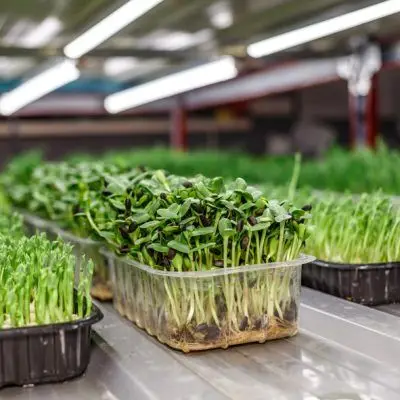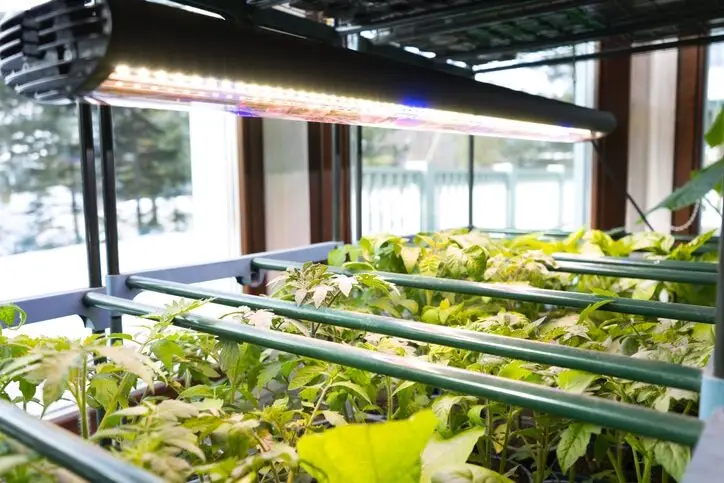What are T5 Grow Lights?

T5 Grow Lights: A Guide for Microgreen Growers
T5 grow lights have become a popular choice for indoor gardeners of all levels, from hobbyists nurturing a few herbs to commercial growers managing vast greenhouses. Their balance of efficiency, affordability, and effectiveness makes them a versatile lighting solution for a wide range of plants and growing setups. This article delves into the world of T5 grow lights, exploring their features, benefits, drawbacks, applications, and offering guidance on choosing the right T5 setup for your needs.
Understanding T5 Technology
The "T5" designation refers to the diameter of the fluorescent tube. The "T" stands for tubular, and the "5" indicates five-eighths of an inch (or 16mm) in diameter. This standardized sizing ensures compatibility between different manufacturers' fixtures and bulbs. T5s are a type of high-output fluorescent lighting, meaning they produce a significant amount of light relative to their energy consumption. This efficiency is a key factor in their popularity.
Key Features and Benefits of T5 Grow Lights
- Energy Efficiency: T5s are significantly more energy-efficient than older fluorescent technologies like T8s and T12s. They produce more light per watt, reducing electricity costs and making them an environmentally friendlier option.
- High Light Output: T5 bulbs deliver a high Photosynthetic Photon Flux (PPF), which is a measure of the light available for photosynthesis. This translates to healthier plant growth and higher yields.
- Compact Size: The slim profile of T5 tubes makes them ideal for tight spaces and vertical farming setups. They can be placed closer to plants without causing excessive heat, maximizing light utilization.
- Long Lifespan: T5 bulbs typically have a long lifespan, often lasting for 20,000 hours or more. This reduces the frequency of replacements and minimizes maintenance costs.
- Full Spectrum Light: While not all T5 bulbs are specifically designed for growing, many are available with a spectrum tailored to plant growth. These "full spectrum" or "broad spectrum" bulbs provide the red and blue light necessary for photosynthesis, as well as other wavelengths that contribute to overall plant health.
- Minimal Heat Output: Compared to high-intensity discharge (HID) lights, T5s produce relatively little heat. This reduces the risk of heat stress for plants and simplifies climate control in indoor growing environments.
- Affordability: T5 fixtures and bulbs are generally more affordable than LED or HID grow lights, making them a budget-friendly option for beginners and experienced growers alike.
- Versatility: T5s can be used for various stages of plant growth, from seed starting and vegetative growth to flowering and fruiting (depending on the specific bulb spectrum). They are also suitable for supplementing natural light in greenhouses.
Drawbacks of T5 Grow Lights
- Lower Light Intensity Compared to HID: While T5s offer good light output, they are not as intense as HID lights, such as High-Pressure Sodium (HPS) or Metal Halide (MH) lamps. This means they may not be the best choice for plants with very high light requirements or for covering large areas with a single fixture.
- Bulb Replacement: Although they have a long lifespan, T5 bulbs will eventually need replacing. This adds to the ongoing cost of operation.
- Glass Tubes: T5 bulbs are made of glass, making them susceptible to breakage. Care must be taken when handling and installing them.
- Limited Spectrum Customization: While "full spectrum" T5 bulbs are available, the degree of spectrum customization is not as extensive as with some LED grow lights, where individual wavelengths can be precisely controlled.
- Ballast Requirement: T5 fixtures require a ballast to regulate the flow of electricity to the bulbs. While electronic ballasts are now common and more efficient than older magnetic ballasts, they can still be a point of failure.
Applications of T5 Grow Lights
- Seed Starting: T5s are excellent for starting seeds and nurturing seedlings due to their broad spectrum light and low heat output.
- Vegetative Growth: T5s provide sufficient light for the vegetative stage of plant growth, promoting healthy leaf and stem development.
- Supplemental Lighting: T5s can be used to supplement natural sunlight in greenhouses or indoor areas with limited light.
- Vertical Farming: The compact size of T5s makes them ideal for vertical farming systems, where space is limited.
- Hydroponics and Aquaponics: T5s are suitable for lighting hydroponic and aquaponic growing systems.
- Houseplants: T5s can provide the necessary light for houseplants that are not receiving enough natural light.
- Microgreens: T5s are a popular choice for growing microgreens indoors.
Choosing the Right T5 Grow Lights
When selecting T5 grow lights, consider the following factors:
- Spectrum: Determine the appropriate light spectrum for your plants. "Full spectrum" or "broad spectrum" bulbs are generally suitable for most applications. Some manufacturers offer specific spectrums tailored to vegetative or flowering stages.
- Wattage and Number of Bulbs: Choose the wattage and number of bulbs based on the size of your growing area and the light requirements of your plants. Generally, more bulbs or higher wattage will provide more light.
- Fixture Type: Select a fixture that meets your needs. Options include simple shop lights, more robust commercial-grade fixtures, and specialized reflectors that maximize light output.
- Reflectors: Reflectors can significantly improve the efficiency of T5 grow lights by directing more light towards the plants.
- Ballast Type: Look for fixtures with electronic ballasts, which are more efficient and reliable than magnetic ballasts.
- Mounting Options: Consider how you will mount the fixtures. Some fixtures come with hanging hardware, while others may require separate mounting brackets.
- Budget: Set a budget and choose the best T5 grow lights within your price range.
Tips for Using T5 Grow Lights
- Distance from Plants: T5s can be placed relatively close to plants without causing heat damage. Start with a distance of 6-12 inches and adjust as needed.
- Photoperiod: Provide your plants with the appropriate photoperiod (light cycle). This will vary depending on the species and growth stage.
- Regular Bulb Replacement: Replace T5 bulbs regularly, even if they are still working, as their light output can decrease over time.
- Cleanliness: Keep your T5 fixtures and bulbs clean to ensure optimal light output.
- Monitor Plant Growth: Observe your plants closely for signs of light deficiency or excess. Adjust the lighting as needed.
What about T5 LED Grow Lights?
While the "T5" designation originally referred to fluorescent tubes, the term is now sometimes used to describe LED grow lights that are designed to be a direct replacement for traditional T5 fluorescent fixtures.
So, yes, there are LED grow lights that are marketed as "T5 LED grow lights." Check out the Natural Yield Microgreens Grow Light page, which are all T5 "LED" Grow Lights.
These LED lights are designed to fit into the same fixtures as traditional T5 fluorescent tubes, making it easy to upgrade your existing setup to LED technology. They often maintain the same form factor and connection type as T5 fluorescents.
Here's why this can be a bit tricky
- "T5" historically means fluorescent: The original meaning of T5 is tied to the size and type of fluorescent tube.
- LEDs are different technology: LEDs (Light Emitting Diodes) are a fundamentally different technology than fluorescent lighting.
Why the confusion
Manufacturers are essentially leveraging the familiarity of the "T5" term to make it easier for consumers to understand that these LED lights are designed as replacements for traditional T5 fluorescent tubes.
Benefits of T5 LED Grow Lights
- Energy efficiency: LEDs are generally even more energy-efficient than T5 fluorescents, leading to greater savings on electricity bills.
- Longer lifespan: LED grow lights typically have a longer lifespan than fluorescent bulbs, reducing the need for replacements.
- Improved light spectrum: Some T5 LED grow lights offer more tailored light spectrums for plant growth compared to standard T5 fluorescent bulbs.
- Reduced heat output: LEDs produce less heat than fluorescent bulbs, reducing the risk of heat stress for plants.
If you're considering T5 LED grow lights, make sure to check the specifications carefully to ensure they meet your needs. Pay attention to the light output, spectrum, wattage, and other features to make an informed decision.
Conclusion
T5 grow lights offer a compelling combination of efficiency, affordability, and effectiveness, making them a valuable tool for indoor gardeners. By understanding their features, benefits, and drawbacks, and by carefully considering the factors outlined in this article, you can choose the right T5 setup to create a thriving indoor garden. While newer technologies like LEDs offer more tailored spectrum control and potentially longer lifespans, T5s remain a viable and cost-effective option, particularly for beginners and those working within a budget. Their versatility and ease of use ensure that T5 grow lights will continue to play a significant role in the world of indoor horticulture for years to come.


